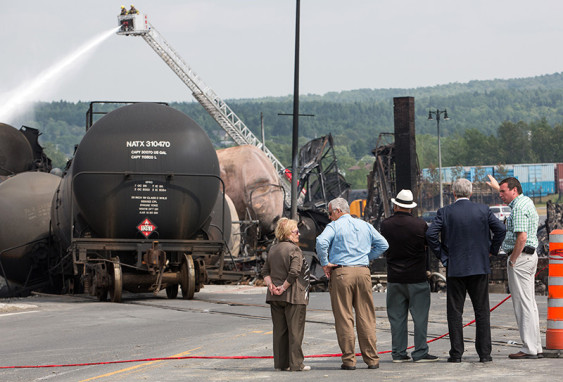
Canadian PM Stephen Harper surveys the damage in Lac-Mégantic the day after the explosion. Photo credit Stephen Harper, cc.
Last week saw a profusion of head-scratching news stories about July’s catastrophic oil train explosion in Quebec after the Transportation Safety Board of Canada announced that the tanker cars had been mislabeled. It turns out that although the rail cars were correctly classified as containing a “dangerous good,” a label that applies to all types of crude oil, they were incorrectly designated as PG III, the least dangerous sub-category, when they should have been labeled as the more dangerous PG II. (PG I is the most dangerous type.)
Mislabeling is a problem, to be sure, but it’s hardly the main issue. What none of the media accounts properly explained was why the crude oil—which does not normally explode—was so dangerous to begin with.
What we can learn from digging into initial reports from Canadian safety investigators is that the train was bearing crude oil from the Bakken oil fields of North Dakota, the same type of oil that is scaling up for massive increases in rail shipping in the Northwest. It’s also clear that the oil had a relatively low flash point for crude, which means that it would have ignited at lower temperatures. But at this point, we don’t know a lot more about the evidently deadly composition of the product.
Some experts speculate that the culprit may be hydrogen sulfide, a colorless, flammable, and extremely hazardous gas that is sometimes associated with Bakken oil. According to the oil industry, hydrogen sulfide is explosive when mixed with air, and it can cause severe corrosion to oil transport equipment, including pipelines.
We also know that hydrogen sulfide is present in large quantities in some stocks of Bakken oil. For example, in June, pipeline operator Enbridge sent shockwaves through the industry when it appealed to federal US regulators for permission to limit the amount of hydrogen sulfide that oil companies move in its pipelines after the company discovered extremely high concentrations of the gas—roughly 12 times lethal levels—in an oil storage tank at one of its rail unloading facilities.
The government agreed with Enbridge:
The U.S. Occupational Safety & Health Administration (OSHA) “sets maximum exposure limits at either 10 or 20 ppm” with an “absolute prohibition of exposure above 50 ppm,” FERC noted.
Exposure to sulfide gas vapors at levels of 100 ppm can cause death. Enbridge found 1,200 ppm in one of its storage tanks. [emphasis added]
At low concentrations (under 1 ppm) hydrogen sulfide gas is characteristically associated with a rotten egg smell; at higher concentrations (over 30 ppm) it has a sickly sweet odor; and at high levels (over 100 ppm) it is considered odorless because the gas paralyzes the olfactory nerves in the nose. It’s nasty stuff: chronic exposure can cause lung, liver, and kidney damage, infertility, immune system suppression, blood disorders, gene mutations, birth defects, and cancer.
Even worse, environmental advocates point out:
Dr. Paul Goldstein, Ph.D., Professor of Toxicology warns that “Crude oil is not readily biodegradable, and the effects of exposure to this toxin will be felt not only acutely, but from generation to generation. Children and pregnant mothers are at significant risk. All exposures, no matter how seemingly insignificant, may prove to be consequential. What may seem to be a relatively trivial exposure in a healthy individual may potentially prove catastrophic…” [emphasis added].
As awful as hydrogen sulfide exposure may be, however, it poses an even more immediate danger owing to its extreme flammability. If the Lac-Mégantic oil train disaster was, indeed, caused by high concentrations of hydrogen sulfide, one has to wonder whether Bakken oil-bearing trains are at all safe for local communities.
At minimum, the public should know a lot more. Before the Northwest (or any other region) goes further with the rush of plans for oil-by-rail projects, there are at least three conditions the public should insist on:
- That regulators carefully study the dangers posed by hydrogen sulfide gas in Bakken oil storage and transport facilities;
- That railway companies provide detailed information about oil trains to the public, including the timing and routing of these trains; and
- That local and state governments ensure that first responders are appropriately trained and equipped to deal with a Lac-Mégantic-like disaster.
Credit to Devorah Ancel at the Sierra Club and Lauren Goldberg at Columbia Riverkeeper for bringing the hydrogen sulfide issue to my attention.









KClark
This is not about hydrogen sulfide, this is about API Gravity, something which has yet to be mentioned or evidently understood by those investigating Bakken Oil. API Gravity relates directly to density, the higher the number, the lighter or less dense the oil. Crude oil is a composite of many different hydrocarbons, and has a broad range of flash points, not a single flash point. The Bakken has reported for years an API Gravity range of 36-44, with anything above 31 being a light crude oil. Heavy crude oil is in the 20’s range. Assays of Bakken (or any oil) in 38-40 range indicate 30-35% volatile hydrocarbons, meaning napthas, gasoline, light distillates, and entrenched liquefied gases such as propane, butane, etc.
But Lac-Megantic was largely a “crush” issue meaning app. 30 cars were immediately crushed so that the oil literally burst from these cars, for the others it was boiling point issue, meaning that the fire boiled the oil in the sealed cars, over pressured the metal rating, and then the released gas ignited resulting in the fireballs that were seen. All crude oils burn intensely, what happened at Lac-Megantic was not simply due to a lighter grade crude oil transported, but a crude oil period.
lee James
-Really helpful discussion! Thank you. I think it safe to say that a lot of us are learning a lot more about oil and fossil fuels than we used to know.